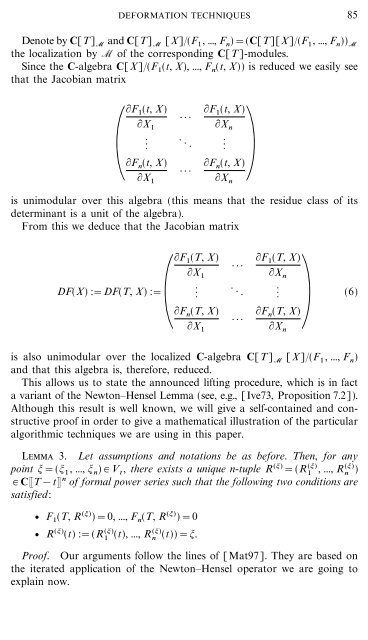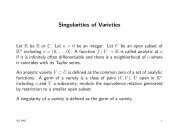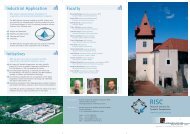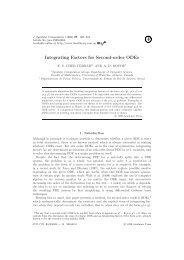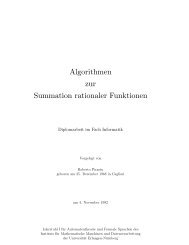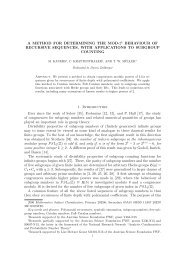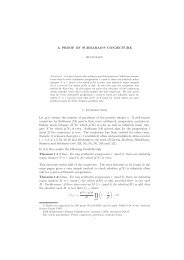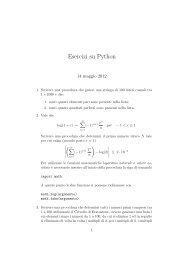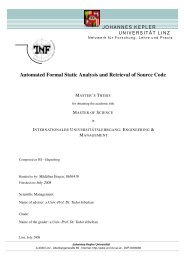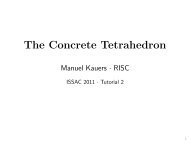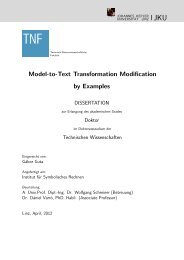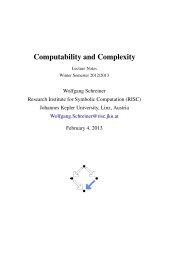Deformation Techniques for Efficient Polynomial Equation ... - RISC
Deformation Techniques for Efficient Polynomial Equation ... - RISC
Deformation Techniques for Efficient Polynomial Equation ... - RISC
You also want an ePaper? Increase the reach of your titles
YUMPU automatically turns print PDFs into web optimized ePapers that Google loves.
DEFORMATION TECHNIQUES<br />
85<br />
Denote by C[T] M and C[T] M [X](F 1 , ..., F n )=(C[T][X](F 1 , ..., F n )) M<br />
the localization by M of the corresponding C[T]-modules.<br />
Since the C-algebra C[X](F 1 (t, X), ..., F n (t, X)) is reduced we easily see<br />
that the Jacobian matrix<br />
F 1 (t, X) F<br />
}}}<br />
1 (t, X)<br />
\<br />
X 1 X n<br />
.<br />
b . . b<br />
+<br />
F n (t, X) F<br />
}}}<br />
n (t, X)<br />
X 1 X n<br />
is unimodular over this algebra (this means that the residue class of its<br />
determinant is a unit of the algebra).<br />
From this we deduce that the Jacobian matrix<br />
F 1 (T, X) F 1 (T, X)<br />
}}}<br />
X 1 X n<br />
.<br />
DF(X) :=DF(T, b<br />
X):=\<br />
. . b<br />
+<br />
(6)<br />
F n (T, X) F n (T, X)<br />
}}}<br />
X 1 X n<br />
is also unimodular over the localized C-algebra C[T] M [X](F 1 , ..., F n )<br />
and that this algebra is, there<strong>for</strong>e, reduced.<br />
This allows us to state the announced lifting procedure, which is in fact<br />
a variant of the NewtonHensel Lemma (see, e.g., [Ive73, Proposition 7.2]).<br />
Although this result is well known, we will give a self-contained and constructive<br />
proof in order to give a mathematical illustration of the particular<br />
algorithmic techniques we are using in this paper.<br />
Lemma 3. Let assumptions and notations be as be<strong>for</strong>e. Then, <strong>for</strong> any<br />
point !=(! 1 , ..., ! n )#V t , there exists a unique n-tuple R (!) =(R (!)<br />
1<br />
, ..., R(!) ) n<br />
# CT&t n of <strong>for</strong>mal power series such that the following two conditions are<br />
satisfied:<br />
v F 1 (T, R (!) )=0, ..., F n (T, R (!) )=0<br />
v R (!) (t) :=(R (!)<br />
1<br />
(t), ..., R(!) (t))=!.<br />
n<br />
Proof. Our arguments follow the lines of [Mat97]. They are based on<br />
the iterated application of the NewtonHensel operator we are going to<br />
explain now.


